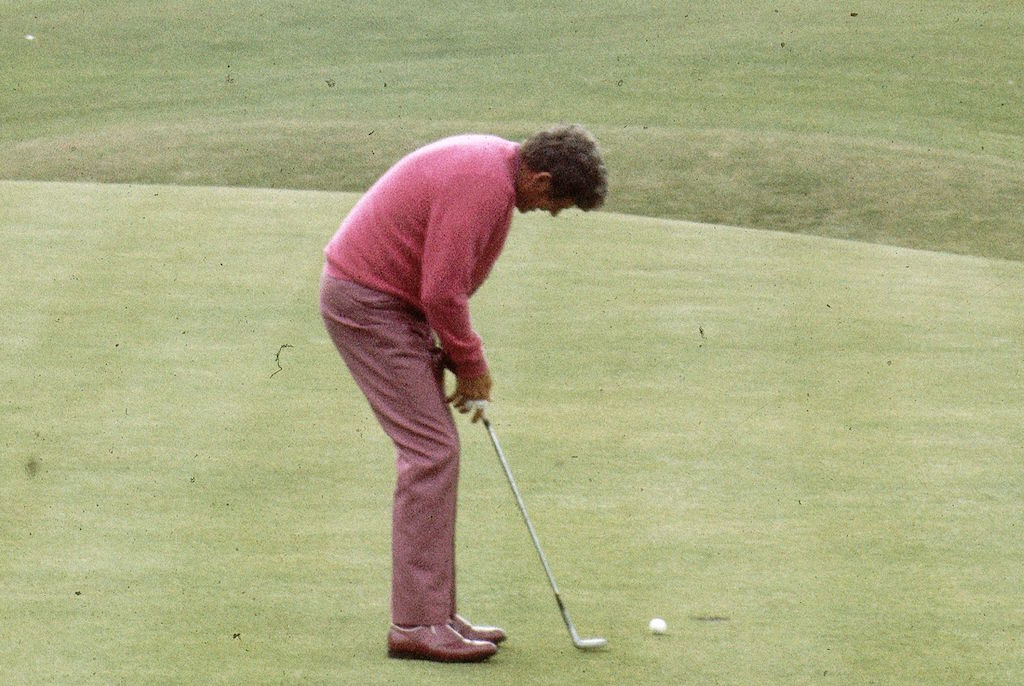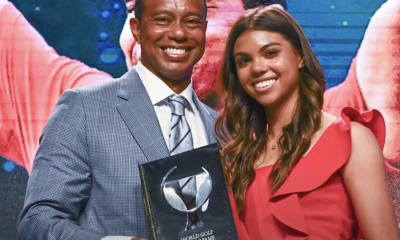Opinion & Analysis
Was this the Yip Heard ‘Round the World? Or not a yip at all…

The other day while doing research on an article about “the yips,” I happened to watch the replay of the 1970 Open Championship at St. Andrews with Henry Longhurst calling the play-by-play.
This was the tournament in which Doug Sanders missed a short putt on the final hole to win the championship. In his defense, the putt was a downhill left-to-right slider, the most challenging putt for a right-handed player.
David Pelz, NASA scientist turned putting guru, refers to these sidewinders as “facing putts,” meaning that when the player sets up to the ball, they can see the hole in their periapical vision. This is opposed to right-to-left putts, in which the hole is essentially blocked from view by the player’s body.
The tendency with a “facing putt” is for the player to direct the ball at the hole, rather than on a line above the cup, causing the ball to finish on the low side. What happened as Doug Sanders stood over the ball? We’ll come back to that moment shortly. In the meantime, let’s see what events led up to that point.
The Road Hole
The tendency when examining a win or a loss is to focus only on what happened at the end of the contest, ignoring what led up to the penultimate moment. In this case, to put that final putt into its proper context, we need to go back to the 17th tee, which is where Sanders began to unwind.
Sanders and Trevino were playing together in the final group. Trevino had started the day at 8-under par, but he had slipped down the leaderboard to 2-under by the time they’d reached the 17th hole. Sanders was first to play off the 17th tee, but only after a bizarre series of events occurred. As Sanders stood over the ball with the hotel looming to his right, he turned his head back and forth, looking down his target line more than 20 times. Then, when it appeared that he was ready to pull his club away from the ball, he stepped away to wipe the grip of his driver with a towel.
Sanders then returned to the ball and the ritual began again, but this time the number of looks exceeded the first. And finally, when it appeared that he would never hit the ball, he began his swing, hitting the ball weakly down the right side of the fairway. Trevino played his tee shot down the left side, and with that, the two players started walking down the fairway.
Sander’s ball finished a good 20 yards behind Trevino, leaving him a considerable distance away from the green. After talking with his caddie, Sanders chose to play a fairway wood toward the right side of green. Sanders pulled it slightly to the left, and he and his caddie watched as his ball bounded into the left front bunker.
In 1970, the face of the Road Hole Bunker was not as steep as it is today, but it still represented a significant challenge to those who found themselves in it. The pin was tucked just behind the bunker, leaving Sanders only a few feet of green to work with. He dug his feet into the sand and then proceeded to play a brilliant shot, leaving the ball just a few inches away from the hole. He tapped in for a par, preserving his one-shot lead over Nicklaus.
Valley of Sin
On the 18th hole, the two men drove down the left side of the fairway. The pin was located just a few feet behind the “Valley of Sin.” Sanders walked from his ball all the way to the green, and then, taking a long look at the position of the pin, he walked back to his ball. Sanders was the first to play. His wedge shot landed well past the pin, stopping some 25 feet away. Trevino, who at this point nothing to gain or lose, played his wedge shot to roughly 15 feet behind the pin.
After Trevino had played, the two men walked up through the “Valley of Sin” together and made their way toward the back of the green. They each marked their ball and walked forward toward the hole to survey the area around it. The obvious challenge facing Sanders was that he needed to roll the ball to the hole, but at the same time, not run it too far by the cup.
For The Win
Sanders, looking first at the hole and then back again at the ball, proceed to take several glances back and forth before hitting his first putt. It stopped about 2.5 feet from the hole. The championship belonged to Sanders if he could negotiate the next putt. If he were to miss it, he would fall into a tie with Jack Nicklaus, who was already in the clubhouse waiting for him to finish. In the event that the two should tie, it would be broken by an 18-hole playoff the following day.
In preparation to hit what he hoped was his final putt of the tournament, Sanders placed his putter behind the ball. And then, as he had done before, he began to swivel eyes back and forth… to the ball, to the hole, to the ball, to the hole, to the ball, to the hole. And then, perhaps sensing that he had already spent more time than he should over the ball, he appeared to rush the putt once he’d settled over it.
The unthinkable happened.
Sanders missed the putt, letting it slide to the right below the hole. The following day, Nicklaus won the 18-hole playoff, ending Sander’s bid for his first and only major.
Did He Yip It?
And now to the point. Do you think Sanders yipped that final putt? The answer to that question would depend on how you define the yips, so let me help you. There are any number of people who say they have yipped a putt or that they have “the yips.” In fact, they are more likely suffering from poor mechanics that are exacerbated by performance anxiety.
“The True Yips,” as I define the condition, are only present when there is a visible muscular spasm in anticipation of striking the ball. And to the question as to whether Doug Sanders yipped the putt, I’d invite you to watch the replay on the internet. What you will observe as you watch him putt is that there is no visible spasm present at any point in his stroke.
Sanders just made the same mistake as any other golfer might who was playing with his friends on a Saturday morning; he didn’t start the ball on a line high enough above the cup when playing a left-to-right putt.
And so, for the record, Doug Sanders’ miss at the final hole of the 1970 British Open was not a “true yip,” but just a miscalculation of line and speed.
—
Rod Lidenberg is the author of a new book based on this experience treating students with The Yips. The book is entitled “The Yips: Dancing with the Devil, Rewiring Your System for Success.” The book will be released for publication sometime before the end of the year.
- LIKE83
- LEGIT13
- WOW1
- LOL1
- IDHT0
- FLOP2
- OB1
- SHANK25
19th Hole
Vincenzi’s LIV Golf Singapore betting preview: Course specialist ready to thrive once again

After another strong showing in Australia, LIV Golf will head to Sentosa Golf Club in Singapore looking to build off of what was undoubtedly their best event to date.
Sentosa Golf Club sits on the southern tip of Singapore and is one of the most beautiful courses in the world. The course is more than just incredible scenically; it was also rated 55th in Golf Digest’s top-100 courses in 2022-2023 and has been consistently regarded as one of the best courses in Asia. Prior to being part of the LIV rotation, the course hosted the Singapore Open every year since 2005.
Sentosa Golf Club is a par 71 measuring 7,406 yards. The course will require precise ball striking and some length off the tee. It’s possible to go low due to the pristine conditions, but there are also plenty of hazards and difficult spots on the course that can bring double bogey into play in a hurry. The Bermudagrass greens are perfectly manicured, and the course has spent millions on the sub-air system to keep the greens rolling fast. I spoke to Asian Tour player, Travis Smyth, who described the greens as “the best [he’s] ever played.”
Davis Love III, who competed in a Singapore Open in 2019, also gushed over the condition of the golf course.
“I love the greens. They are fabulous,” the 21-time PGA Tour winner said.
Love III also spoke about other aspects of the golf course.
“The greens are great; the fairways are perfect. It is a wonderful course, and it’s tricky off the tee.”
“It’s a long golf course, and you get some long iron shots. It takes somebody hitting it great to hit every green even though they are big.”
As Love III said, the course can be difficult off the tee due to the length of the course and the trouble looming around every corner. It will take a terrific ball striking week to win at Sentosa Golf Club.
In his pre-tournament press conference last season, Phil Mickelson echoed many of the same sentiments.
“To play Sentosa effectively, you’re going to have a lot of shots from 160 to 210, a lot of full 6-, 7-, 8-iron shots, and you need to hit those really well and you need to drive the ball well.”
Golfers who excel from tee to green and can dial in their longer irons will have a massive advantage this week.
Stat Leaders at LIV Golf Adelaide:
Fairways Hit
1.) Louis Oosthuizen
2.) Anirban Lahiri
3.) Jon Rahm
4.) Brendan Steele
5.) Cameron Tringale
Greens in Regulation
1.) Brooks Koepka
2.) Brendan Steele
3.) Dean Burmester
4.) Cameron Tringale
5.) Anirban Lahiri
Birdies Made
1.) Brendan Steele
2.) Dean Burmester
3.) Thomas Pieters
4.) Patrick Reed
5.) Carlos Ortiz
LIV Golf Individual Standings:
1.) Joaquin Niemann
2.) Jon Rahm
3.) Dean Burmester
4.) Louis Oosthuizen
5.) Abraham Ancer
LIV Golf Team Standings:
1.) Crushers
2.) Legion XIII
3.) Torque
4.) Stinger GC
5.) Ripper GC
LIV Golf Singapore Picks
Sergio Garcia +3000 (DraftKings)
Sergio Garcia is no stranger to Sentosa Golf Club. The Spaniard won the Singapore Open in 2018 by five strokes and lost in a playoff at LIV Singapore last year to scorching hot Talor Gooch. Looking at the course setup, it’s no surprise that a player like Sergio has played incredible golf here. He’s long off the tee and is one of the better long iron players in the world when he’s in form. Garcia is also statistically a much better putter on Bermudagrass than he is on other putting surfaces. He’s putt extremely well on Sentosa’s incredibly pure green complexes.
This season, Garcia has two runner-up finishes, both of them being playoff losses. Both El Camaleon and Doral are courses he’s had success at in his career. The Spaniard is a player who plays well at his tracks, and Sentosa is one of them. I believe Sergio will get himself in the mix this week. Hopefully the third time is a charm in Singapore.
Paul Casey +3300 (FanDuel)
Paul Casey is in the midst of one of his best seasons in the five years or so. The results recently have been up and down, but he’s shown that when he’s on a golf course that suits his game, he’s amongst the contenders.
This season, Casey has finishes of T5 (LIV Las Vegas), T2 (LIV Hong Kong), and a 6th at the Singapore Classic on the DP World Tour. At his best, the Englishman is one of the best long iron players in the world, which makes him a strong fit for Sentosa. Despite being in poor form last season, he was able to fire a Sunday 63, which shows he can low here at the course.
It’s been three years since Casey has won a tournament (Omega Dubai Desert Classic in 2021), but he’s been one of the top players on LIV this season and I think he can get it done at some point this season.
Mito Pereira +5000 (Bet365)
Since Mito Pereira’s unfortunate demise at the 2022 PGA Championship, he’s been extremely inconsistent. However, over the past few months, the Chilean has played well on the International Series as well as his most recent LIV start. Mito finished 8th at LIV Adelaide, which was his best LIV finish this season.
Last year, Pereira finished 5th at LIV Singapore, shooting fantastic rounds of 67-66-66. It makes sense why Mito would like Sentosa, as preeminent ball strikers tend to rise to the challenge of the golf course. He’s a great long iron player who is long and straight off the tee.
Mito has some experience playing in Asia and is one of the most talented players on LIV who’s yet to get in the winner’s circle. I have questions about whether or not he can come through once in contention, but if he gets there, I’m happy to roll the dice.
Andy Ogletree +15000 (DraftKings)
Andy Ogletree is a player I expected to have a strong 2024 but struggled early in his first full season on LIV. After failing to crack the top-25 in any LIV event this year, the former U.S. Amateur champion finally figured things out, finished in a tie for 3rd at LIV Adelaide.
Ogletree should be incredible comfortable playing in Singapore. He won the International Series Qatar last year and finished T3 at the International Series Singapore. The 26-year-old was arguably the best player on the Asian Tour in 2023 and has been fantastic in the continent over the past 18 months.
If Ogletree has indeed found form, he looks to be an amazing value at triple-digit odds.
- LIKE3
- LEGIT3
- WOW1
- LOL2
- IDHT0
- FLOP2
- OB0
- SHANK0
Opinion & Analysis
Ryan: Lessons from the worst golf instructor in America

In Tampa, there is a golf course that boasts carts that do not work, a water range, and a group of players none of which have any chance to break 80. The course is overseen by a staff of crusty men who have succeeded at nothing in life but ending up at the worst-run course in America. However, this place is no failure. With several other local courses going out of business — and boasting outstanding greens — the place is booked full.
While I came for the great greens, I stayed to watch our resident instructor; a poor-tempered, method teacher who caters to the hopeless. At first, it was simply hilarious. However, after months of listening and watching, something clicked. I realized I had a front-row seat to the worst golf instructor in America.
Here are some of my key takeaways.
Method Teacher
It is widely accepted that there are three types of golf instructors: system teachers, non-system teachers, and method teachers. Method teachers prescribe the same antidote for each student based on a preamble which teachers can learn in a couple day certification.
Method teaching allows anyone to be certified. This process caters to the lowest caliber instructor, creating the illusion of competency. This empowers these underqualified instructors with the moniker of “certified” to prey on the innocent and uninformed.
The Cult of Stack and Jilt
The Stack and Tilt website proudly boasts, “A golfer swings his hands inward in the backswing as opposed to straight back to 1) create power, similar to a field goal kicker moving his leg in an arc and 2) to promote a swing that is in-to-out, which produces a draw (and eliminates a slice).”
Now, let me tell you something, there is this law of the universe which says “energy can either be created or destroyed,” so either these guys are defying physics or they have no idea what they are taking about. Further, the idea that the first move of the backswing determines impact is conjecture with a splash of utter fantasy.
These are the pontifications of a method — a set of prescriptions applied to everyone with the hope of some success through the placebo effect. It is one thing for a naive student to believe, for a golf instructor to drink and then dispel this Kool-Aid is malpractice.
Fooled by Randomness
In flipping a coin, or even a March Madness bet, there is a 50-50 chance of success. In golf, especially for new players, results are asymmetric. Simply put: Anything can happen. The problem is that when bad instructors work with high handicappers, each and every shot gets its own diagnosis and prescription. Soon the student is overwhelmed.
Now here’s the sinister thing: The overwhelming information is by design. In this case, the coach is not trying to make you better, they are trying to make you reliant on them for information. A quasi Stockholm syndrome of codependency.
Practice
One of the most important scientists of the 20th century was Ivan Pavlov. As you might recall, he found that animals, including humans, could be conditioned into biological responses. In golf, the idea of practice has made millions of hackers salivate that they are one lesson or practice session from “the secret.”
Sunk Cost
The idea for the worst golf instructor is to create control and dependency so that clients ignore the sunk cost of not getting better. Instead, they are held hostage by the idea that they are one lesson or tip away from unlocking their potential.
Cliches
Cliches have the effect of terminating thoughts. However, they are the weapon of choice for this instructor. Add some hyperbole and students actually get no information. As a result, these players couldn’t play golf. When they did, they had no real scheme. With no idea what they are doing, they would descend into a spiral of no idea what to do, bad results, lower confidence, and running back to the lesson tee from more cliches.
The fact is that poor instruction is about conditioning players to become reliant members of your cult. To take away autonomy. To use practice as a form of control. To sell more golf lessons not by making people better but through the guise that without the teacher, the student can never reach their full potential. All under the umbrella of being “certified” (in a 2-day course!) and a melee of cliches.
This of course is not just happening at my muni but is a systemic problem around the country and around the world, the consequences of which are giving people a great reason to stop playing golf. But hey, at least it’s selling a lot of golf balls…
- LIKE17
- LEGIT1
- WOW0
- LOL4
- IDHT1
- FLOP0
- OB0
- SHANK15
19th Hole
Vincenzi’s 2024 Zurich Classic of New Orleans betting preview

The PGA TOUR heads to New Orleans to play the 2023 Zurich Classic of New Orleans. In a welcome change from the usual stroke play, the Zurich Classic is a team event. On Thursday and Saturday, the teams play best ball, and on Friday and Sunday the teams play alternate shot.
TPC Louisiana is a par 72 that measures 7,425 yards. The course features some short par 4s and plenty of water and bunkers, which makes for a lot of exciting risk/reward scenarios for competitors. Pete Dye designed the course in 2004 specifically for the Zurich Classic, although the event didn’t make its debut until 2007 because of Hurricane Katrina.
Coming off of the Masters and a signature event in consecutive weeks, the field this week is a step down, and understandably so. Many of the world’s top players will be using this time to rest after a busy stretch.
However, there are some interesting teams this season with some stars making surprise appearances in the team event. Some notable teams include Patrick Cantlay and Xander Schauffele, Rory McIlroy and Shane Lowry, Collin Morikawa and Kurt Kitayama, Will Zalatoris and Sahith Theegala as well as a few Canadian teams, Nick Taylor and Adam Hadwin and Taylor Pendrith and Corey Conners.
Past Winners at TPC Louisiana
- 2023: Riley/Hardy (-30)
- 2022: Cantlay/Schauffele (-29)
- 2021: Leishman/Smith (-20)
- 2019: Palmer/Rahm (-26)
- 2018: Horschel/Piercy (-22)
- 2017: Blixt/Smith (-27)
2024 Zurich Classic of New Orleans Picks
Tom Hoge/Maverick McNealy +2500 (DraftKings)
Tom Hoge is coming off of a solid T18 finish at the RBC Heritage and finished T13 at last year’s Zurich Classic alongside Harris English.
This season, Hoge is having one of his best years on Tour in terms of Strokes Gained: Approach. In his last 24 rounds, the only player to top him on the category is Scottie Scheffler. Hoge has been solid on Pete Dye designs, ranking 28th in the field over his past 36 rounds.
McNealy is also having a solid season. He’s finished T6 at the Waste Management Phoenix Open and T9 at the PLAYERS Championship. He recently started working with world renowned swing coach, Butch Harmon, and its seemingly paid dividends in 2024.
Keith Mitchell/Joel Dahmen +4000 (DraftKings)
Keith Mitchell is having a fantastic season, finishing in the top-20 of five of his past seven starts on Tour. Most recently, Mitchell finished T14 at the Valero Texas Open and gained a whopping 6.0 strokes off the tee. He finished 6th at last year’s Zurich Classic.
Joel Dahmen is having a resurgent year and has been dialed in with his irons. He also has a T11 finish at the PLAYERS Championship at TPC Sawgrass which is another Pete Dye track. With Mitchell’s length and Dahmen’s ability to put it close with his short irons, the Mitchell/Dahmen combination will be dangerous this week.
Taylor Moore/Matt NeSmith +6500 (DraftKings)
Taylor Moore has quickly developed into one of the more consistent players on Tour. He’s finished in the top-20 in three of his past four starts, including a very impressive showing at The Masters, finishing T20. He’s also finished T4 at this event in consecutive seasons alongside Matt NeSmith.
NeSmith isn’t having a great 2024, but has seemed to elevate his game in this format. He finished T26 at Pete Dye’s TPC Sawgrass, which gives the 30-year-old something to build off of. NeSmith is also a great putter on Bermudagrass, which could help elevate Moore’s ball striking prowess.
- LIKE8
- LEGIT3
- WOW1
- LOL1
- IDHT0
- FLOP3
- OB1
- SHANK2
-

 19th Hole1 week ago
19th Hole1 week agoJustin Thomas on the equipment choice of Scottie Scheffler that he thinks is ‘weird’
-

 19th Hole1 week ago
19th Hole1 week ago‘Absolutely crazy’ – Major champ lays into Patrick Cantlay over his decision on final hole of RBC Heritage
-

 19th Hole3 weeks ago
19th Hole3 weeks agoTwo star names reportedly blanked Jon Rahm all week at the Masters
-

 19th Hole2 weeks ago
19th Hole2 weeks agoReport: LIV Golf identifies latest star name they hope to sign to breakaway tour
-

 19th Hole2 weeks ago
19th Hole2 weeks agoNeal Shipley presser ends in awkward fashion after reporter claims Tiger handed him note on 8th fairway
-

 19th Hole2 weeks ago
19th Hole2 weeks agoBrandel Chamblee has ‘no doubt’ who started the McIlroy/LIV rumor and why
-

 Equipment3 weeks ago
Equipment3 weeks agoWhat we know about Bryson DeChambeau’s 3D-printed Avoda irons
-

 19th Hole6 days ago
19th Hole6 days agoLET pro gives detailed financial breakdown of first week on tour…and the net result may shock you


























David
Dec 27, 2017 at 6:47 pm
That is not a yip
Stan
Dec 27, 2017 at 3:04 pm
Not the yips, a misread
“But was it really a choke? Before Sanders took the putter back, the man who set the pin, Gerald Micklem, told those in the Members Room in the clubhouse that Sanders would miss it because he “won’t see the break because you can’t see the break”.
Source
http://www.nydailynews.com/archives/sports/old-st-andrews-article-1.878308
peter
Dec 27, 2017 at 1:17 am
Yep, rushed the stroke and pushed it.
Drbopperthp
Dec 26, 2017 at 6:04 pm
He choked, plain and simple.
John K
Dec 26, 2017 at 3:30 pm
The instant the ball left his putter it appears he tried to guide it. Been there done that! I would call it uncertainty in his decision more then a yip!
Michael
Dec 26, 2017 at 2:12 pm
See the guy quite often hitting balls at the range. He is the nicest dude in the world and talks to everyone about the game. I personally find it stupid to call this putt a choke when the hole before he hit one of the greatest bunker shots ever. Sure he might of screwed up moving whatever he saw in his line but it was one hell of an effort to get to that point. The fact is he should of played safer on his approach and played for par.
Hugh
Dec 26, 2017 at 1:43 pm
Pretty sure you meant “peripheral vision,” not “periapical” unless he was lining up the putt with his teeth.
Dan Retief
Dec 26, 2017 at 1:11 pm
I had always believed that Doug Sanders addressed that short putt then leant forward to sweep a pebble, or something, off his line and then went back into his stance and missed. I might even have read it in Sanders’ entertaining autobiography “Come Swing With Me.” The story went that when Ben Hogan, watching on TV in Texas, saw Sanders move to sweep the line he cried out, “step away!” Sanders didn’t and might have slightly altered his stance and alignment. However this is not shown in the clip you have attached. Did it happen? That little putt on the 18th at St Andrews to this day breaks to the right… wonder if poor old Doug at the last second thought he was lining up too far outside the left of the cup and, like the rest of us, self-corrected his stroke by slightly opening the putter face and pushing it to straight, thus it took the break and missed right. Agree that it was not a yip.
Frank Korfanta
Jul 1, 2022 at 12:39 am
Your assessment Dan is 100% correct! The author of this article fails to mention this critical error by Sanders. He didnt rush the putt or yip it, he failed to step off and re-align this challenging slippery left to rignt downhill putt. After he reached over brushed the pebble away or whatever it was he saw, he altered his stance just enough to change his original line. It never had a chance…sadly! Why he didnt step off and re-align the putt is the real mystery?
John Grossi
Dec 26, 2017 at 11:58 am
Sorry, I cannot watch again that stroke.
I truly believe he yipped that putt.
Todd
Dec 26, 2017 at 11:18 am
Agreed, ball never started left of the hole like it needed.
Pete O'Tube
Dec 26, 2017 at 10:59 am
Not quite a yip, but a shove with the right shoulder!